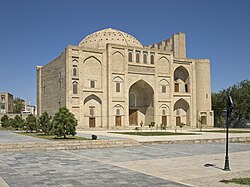It has been suggested that this article be merged into Khanqah of Nodir Devonbegi. (Discuss) Proposed since June 2024. |
Nodir Devonbegi Khanqah (Uzbek: Nodir devonbegi xonaqohi) is a historical monument in the city of Bukhara, Uzbekistan. It was built by Nodir devonbegi (Nadr Mirza Togay ibn Sultan), who was the vizier and nephew of Imam Quli Khan, the ruler of the Bukhara Khanate, in the years 1620–1621. The khanqah, which is a type of building that served as a place of residence and worship for Sufi mystics, is included in the national register of immovable property objects of the material and cultural heritage of Uzbekistan.
| Nodir Devonbegi Khanqah | |
|---|---|
 Nodir Devonbegi Khanqah from the south | |
 | |
| General information | |
| Architectural style | Central Asian |
| Address | Mulla Shamsiddin quarter, Bukhara, Uzbekistan |
| Coordinates | 39°46′29″N 64°25′07″E / 39.7747°N 64.4186°E |
| Year(s) built | 1620-1621 |
| Renovated | 1914-1916 |
| Technical details | |
| Material | Brick |
| Size | 27.5 x 25 meters |
| Floor count | 2 |
History
editThe construction of Nodir Devonbegi Khanqah was completed in 1620, along with a pond that is part of the Lyab-i Hauz ensemble, a complex of historical buildings in the center of Bukhara.[1][2]
Khanqahs were mainly used as places of residence for qalandars and dervishes, who were wandering ascetics and devotees of Sufism. This khanqah has many rooms, and consists of a large portal with two minarets, and 28 small arches on its columns. The portal leads to the central domed hall of Nodir Devonbegi Khanqah, where there are doors on three sides, and a mihrab, a niche that indicates the direction of prayer, on the western side. There are also cells at the corners of the khanqah, where the dervishes could stay and meditate. For some time, the khanqah also served as a madrasa, a religious school, and a hostel and mosque for visitors from far away.[3] This khanqah is located in the Mulla Shamsiddin quarter, and has 14 cells.
The researcher Abdusattor Jumanazarov studied this khanqah, and wrote that this monument was originally a mosque, a place of worship for Muslims. According to his opinion, the monument was initially a Friday mosque, which is a mosque that hosts the congregational prayer on Fridays, and later turned into a khanqah.[4] Currently, the Museum of Ancient Varakhsha and the History of Ceramics, which is part of the Bukhara State Museum-Reserve, operates in this khanqah. This museum was established in 1991 and renamed as the Museum of Ancient Varakhsha and the History of Ceramics in 2017, and its exhibits were changed.[5][6]
Architecture
editNodir Devonbegi Khanqah was built in the style of Central Asian architecture, which is characterized by the use of bricks, domes, arches, and geometric and floral patterns. The khanqah was built together with a pond in the Labi Hovuz ensemble, and has a magnificent portal, a very high arch of the portal, a large dome, and some fragments of paintings on the walls.
The two-sided pointed arches of the mezzanines, which are intermediate floors between the main floors of a building, add elegance to the old appearance. There are doors leading to the cells on both sides of the khanqah. The walls have been repaired several times (in 1914-1916 by Sayyid Olim Khan, the last emir of Bukhara), and the original appearance has changed.
Nodir Devonbegi Khanqah is symmetrical in plan (27.5X25 meters), with a veranda, a khanqah (11.2X11.2 meters) and a two-story dormitory for dervishes on its side. The circular stairs inside the minarets, which are tall towers that are usually attached to a mosque, lead to the top of the building. The khanqah has a large dome, and the walls are decorated with carvings. The inscriptions on the dome have not been preserved. The three niches of the portal arch are decorated with plasterwork windows, which are windows that are made of plaster and have intricate designs. The current appearance of Nodir Devonbegi Khanqah has been transformed into a magnificent, elegant, and attractive monument.[7]
Notes
edit- ^ "The history of the khonaqo". www.bukhara-museum.org. Retrieved 2023-11-10.
- ^ "Nodir Devonbegi madrasasi tarixi va rasmlari". ilmlar.uz. Retrieved 2023-11-10.
- ^ Бухоро тарихий обидалари географияси 2020, p. 27-28.
- ^ Абдусаттор Жуманазар 2017, p. 233.
- ^ "Labi Hovuz yoxud bir juft zirak tarixi". aniq.uz. Retrieved 2023-11-10.
- ^ Жуманазар, Абдусаттор (2017). Бухоро таълим тизими тарихи [History of Bukhara education system] (in Uzbek). Tashkent: Akademnashr. ISBN 978-9943-4728-2-2.
- ^ OʻzME. Volume 1. Tashkent, 2000
References
edit- Bahromov Q, Shodiyev N (2020). Buxoro tarixiy obidalari geografiyasi (in Uzbek). Bukhara: Durdona Publish. p. 129.
- Abdusattor Jumanazarov (2017). Buxoro ta'lim tizimi tarixi (in Uzbek). Tashkent: Akademnashr. p. 592. ISBN 978-9943-4728-2-2.